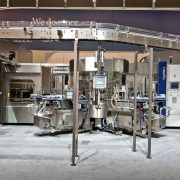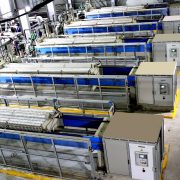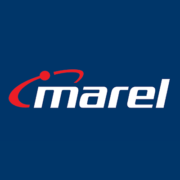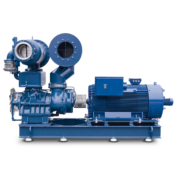Ammann Creates an Internationally Consistent Database in SAP
As a supplier of highly productive, ecological as well as safe and reliable machines and systems for road construction, the Ammann Group based in Langenthal, Switzerland, strives for close contact to their clients worldwide. With the assistance of simus systems GmbH, Karlsruhe, Germany, the company creates a consistent, structured database for the ERP system by SAP. The clear data structure of all materials allows automated translation of article texts into 12 languages. The company will achieve more efficiency and a genuine internationalization.
Jakob Ammann opened his own millwright business in 1869 at the beginning of industrialization – today, the family business takes advantage of the chances of digitization in the sixth generation. Approximately 3,700 members of staff are focusing on construction machines which are efficient in the ecological and economical sense. Mobile and static mixing plants for tarmac have a continuous output of 80 to 400 tonnes per hour. A complete product line of compaction plants – ranging from tampers, rammers continuing to tandem rollers, it also deals with the groundwork for high-performance pavers as a tracked or wheeled model. They allow for optimal asphalting with excellent maneuverability. Furthermore, state-of-the-art compulsory mixers and complete mixing plants are developed for economical production of high-quality concrete in all integral sizes and for various stationary and mobile applications.
Subsidiaries and representative offices ensure the proximity to the client. In addition to the headquarters in Langenthal, there are further production sites in Germany, Italy, the Czech Republic, China, Brazil and India.
Facilitating Global Cooperation
In order to facilitate real international cooperations in development and production and to optimize own processes, a central team works on improving, standardizing and monitoring material master data in a central SAP system under Daniel Schneider, Head of Master Data Management. For the data from the Czech Republic, Italy and India to be used in a global SAP environment, a standardized class structure must be provided: ‘We want to prepare future data migrations with a given structure and therefore facilitate automated translation of new material data into all required languages,’ Daniel Schneider says. So far, most specifications for machines and systems were only available in German, only offers, manuals and similar documents had been translated. In SAP terminology, the term ‘materials’ means individual purchase parts, such as screws and subassemblies or complete construction machines we developed. ‘About one million materials are stored in our system,’ Daniel Schneider says. ‘You cannot get a grip on the required classification only using standard tools by SAP.’ He contacted simus systems for support. The expert from Karlsruhe provides an intelligent software line for structuring, automatic classification and search of geometrical and text data with simus classmate. Further modules take on the automated text generation due to the classification or the calculation of costs based on CAD models. The company supports its clients in the industry in data structure and classification projects. Consequently, information can be retrieved faster due to the implementation of the software modules, the creation of duplicates is prevented and various processes such as material masters data creation are automated.
Classifying Purchased Parts
In the early summer of 2015, Ammann initiated the first phase of the joint project, in which all standard and purchased parts of the company were supposed to be organized. ‘It was very useful that simus systems already provided a preexisting catalog and a class structure,. Daniel Schneider says. ‘These were then collectively adapted to our needs.’ The data of a vast variety of purchased parts – ranging from screws, fluid technology to electric motors is imported to the simus classmate software and divided into classes by predefined rules. The result is presented and discussed in joint workshops with the Ammann experts to solve problematic cases, to add to the rules and make pending decisions. The data volume, which is quite large, covers hundreds of duplicates, each of the departments and companies involved had their own way of completing datasets. This was one of the reasons why the target of reducing about 85 per cent of the data automatically was not quite achieved to the full extend. ‘An own project team has to edit the data manually,’ Daniel Schneider says, because ‘it only makes sense to define rules, if there is enough data they apply to.’ Although editing the materials was not quite done yet, the data was imported to SAP in early 2016. The results look pretty good: ‘In the past, we searched for purchase parts – today, we find them,’ Daniel Schneider describes the most significant success. Previously, only short descriptions of 40 characters or more could be searched for details in order to find datasets with certain features. Today, you can filter for all entered features, so that all motors with a performance between five and six kilowatts are shown.
Structuring Own Designs Systematically
With the momentum of these successes, the second phase of the project was initiated in the beginning of 2016, which refers to product components and products of own designs. The spectrum of these materials ranged from parts designed by us to subassemblies and finished machines and systems. The division creating stationary asphalt and concrete mixing plants, often customized to the clients specifications, went first. ‘Despite the modular structure, a big challenge lies in classifying this extensive portfolio,’ Schneider says. Several design departments were included in the workshops with simus systems. Based on modules and structure plans of its make-up, a classification is worked out and presented. Ultimately, it should be decided on, documented and implemented company-wide. Passing on the completed structure to SAP is planned for the end of 2016. Schneider uses the achieved progress in the area of purchase parts for the motivation of those employees, who managed without a solid structure: ‘We expected the project to be easier,’ the Head of Master Data Management says. ‘The advantages of the first project phase already show that following this path is worthwhile though.’
International Cooperation Facilitated
The specification of new materials is now supported everywhere by the system: Employees are guided through creating an article and have to fill in all provided fields with plausible entries. Subsequently, all features can be displayed and the data quality increases significantly. New languages can be implemented quickly and easily. New markets can therefore be entered more easily and it is simpler to integrate new sites which are added to the group. ‘Previously, we did not get the chance to determine if a part already existed,’ Daniel Schneider says. ‘These days, we have multilingual search options which identify each article of all sites quickly.’ The standardization is supported and the creation of duplicates is avoided. The value will increase substantially again, when all products are included in the new structure. ‘In the meantime, new information needs to be added in different ways,’ Daniel Schneider says. ‘We want to change it as soon as possible.’
Image Rights: Ammann Group, available for publication with source note



 Hauni Maschinenbau GmbH
Hauni Maschinenbau GmbH




